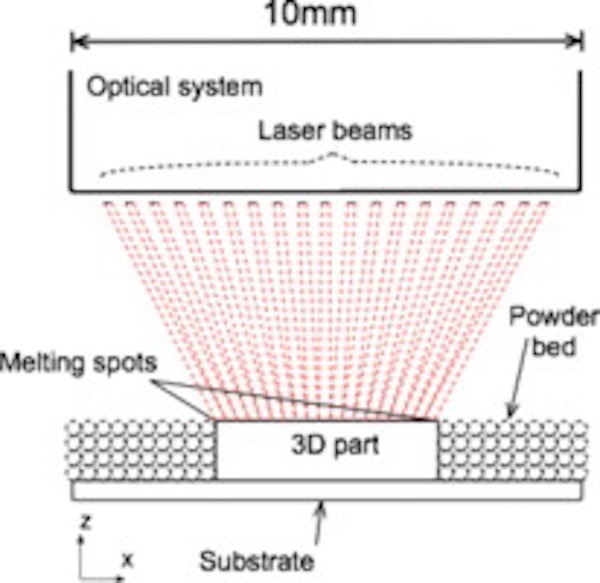
Researchers at the University of Sheffield have developed a unique 3D metal printing process that could dramatically speed up metal printing.
Typical 3D metal printing devices of today employ a single (or up to quad) power source, usually lasers, to selectively melt the surface of a flat bed of fine metal powder. The lasers must traverse all voxels of the printed structure for each layer of the print, sometimes taking considerable time. The laser(s) are directed at the powder surface using mirrors.
There are alternate approaches in the works that could speed things up, but these are yet unproven in terms of part quality. For universal application, 3D printed metal parts must present strengths within tight tolerances and be highly consistent, even after years of production.
The new approach developed at the University of Sheffield is analogous to an inkjet printer: 2D printing would take forever if your system used only one ink nozzle. Modern inkjet systems include print heads with dozens and dozens of nozzles, making it possible to print wide swaths of paper in a single motion.
That’s the style of printing they call “Diode Area Melting”, or “DAM”. Instead of a single (or small number of) lasers, the DAM approach involves using an array of low power laser diode emitters. These emitters are not directed to the powder by an arrangement of mirrors, but instead are positioned above the powder surface and apply their energy directly.
In the image at top you can see how this works: the output from multiple diode lasers are focused on a melting spot directly below the emitter, combining the power from each of the lasers to generate sufficient energy to melt the powder. These emitters are quite small and light, and thus the idea is to gang them together in arrays that can be selectively activated as they pass over a powder bed.
The laser diodes also employ a different, shorter frequency of light that theoretically is more energy efficient. It may be that future machines using DAM may be require far less electricity than current 3D metal printers.
Depending on the number of elements in the diode emitter array, the print speed might be dramatically sped up, as it would be equivalent to adding perhaps dozens of lasers to current equipment.
As of this moment, DAM is only research. However, given its promise I suspect there will be a company popping up shortly that will take advantage of this approach.

